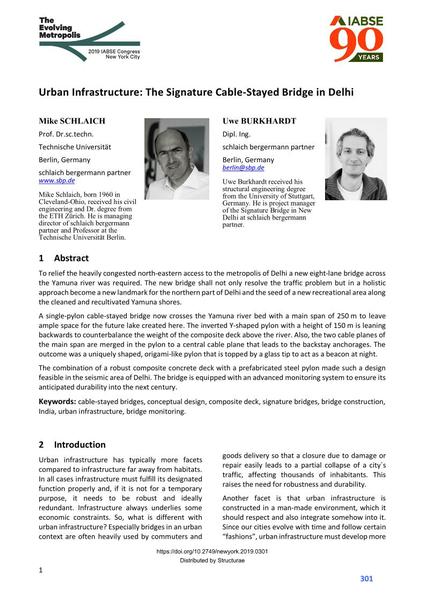Urban Infrastructure: The Signature Cable-Stayed Bridge in Delhi

|
|
|||||||||||
Bibliografische Angaben
| Autor(en): |
Mike Schlaich
(Technische Universität Berlin, Germany)
Uwe Burkhardt (schlaich bergermann partner) |
||||
|---|---|---|---|---|---|
| Medium: | Tagungsbeitrag | ||||
| Sprache(n): | Englisch | ||||
| Tagung: | IABSE Congress: The Evolving Metropolis, New York, NY, USA, 4-6 September 2019 | ||||
| Veröffentlicht in: | The Evolving Metropolis | ||||
|
|||||
| Seite(n): | 301-306 | ||||
| Anzahl der Seiten (im PDF): | 6 | ||||
| DOI: | 10.2749/newyork.2019.0301 | ||||
| Abstrakt: |
To relief the heavily congested north-eastern access to the metropolis of Delhi a new eight-lane bridge across the Yamuna river was required. The new bridge shall not only resolve the traffic problem but in a holistic approach become a new landmark for the northern part of Delhi and the seed of a new recreational area along the cleaned and recultivated Yamuna shores. A single-pylon cable-stayed bridge now crosses the Yamuna river bed with a main span of 250 m to leave ample space for the future lake created here. The inverted Y-shaped pylon with a height of 150 m is leaning backwards to counterbalance the weight of the composite deck above the river. Also, the two cable planes of the main span are merged in the pylon to a central cable plane that leads to the backstay anchorages. The outcome was a uniquely shaped, origami-like pylon that is topped by a glass tip to act as a beacon at night. The combination of a robust composite concrete deck with a prefabricated steel pylon made such a design feasible in the seismic area of Delhi. The bridge is equipped with an advanced monitoring system to ensure its anticipated durability into the next century. |
||||
| Stichwörter: |
Schrägseilbrücken Brückenbau Indien Brückenmonitoring
|
||||

